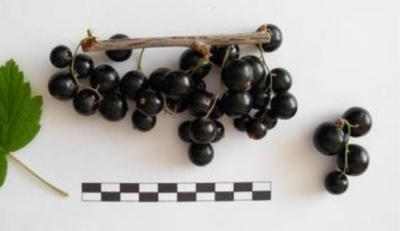
- Authors: Z.S. Zotova, I. P. Kalinina, N. I. Nazaryuk, M. A. Pershina, I. L. Teslya, Research Institute of Horticulture of Siberia named after M.A. Lisavenko
- Appeared when crossing: Bradthorpe x Curiosity
- Year of approval: 2004
- Ripening terms: late ripening
- Growth type: medium-sized
- Yield: high
- Appointment: universal
- Berry weight, g: 2,1-3,3
- Tasting assessment: raw berries - 4.5 points, jam - 4.9 points, compote - 7 points, juice - 4.9 points
- Escapes: medium, slightly curved, green
Harmony currant is a variety with very large black berries, bred by Russian breeders. The plant easily adapts to different climatic conditions, begins to bear fruit 2 years after planting. It is a versatile variety for fresh consumption and processing, high in pectins and vitamin C.
Breeding history
The variety was bred by breeders of the Lisavenko Research Institute of Horticulture of Siberia when crossing currants Bredthorp x Dikovinka. Harmony was entered in the state register in 2004. But she was withdrawn long before that. The variety has been known to gardeners since 1980, during this time it has managed to perfectly recommend itself when grown in different regions of the Russian Federation.
Description of the variety
Harmony currant bushes are medium-sized, with moderate spreading and density. The shoots are short, slightly bent, painted green at a young age, and become beige as they mature. Crown foliage is moderate. It is colored in a light green hue, and is characterized by slight wrinkling of the plates. Flowers are small, goblet, drooping racemes, medium length, reaching 72 mm.
Characteristics of berries
The berries have good transportability due to dry separation from the branches during collection, dense skin. The surface of each is painted in a rich black color, the mass reaches 2.1-3.3 g. The berries are round, shiny, with a small amount of seeds inside.
Taste qualities
Currant is sweet and sour, with a strong aroma. The content of ascorbic acid and pectins in the pulp is high. Raw berries receive a tasting score of 4.5 points. When processed, these indicators turn out to be even higher.
Ripening and fruiting
A late ripening variety, early-growing, characterized by the simultaneous ripening of all berries.

Yield
The variety has high fruiting rates. 4.2 kg of berries are harvested from the bush. The yield when grown on an industrial scale reaches an average of 89 c / ha, the maximum recorded indicators are 20 t / ha.
Growing regions
Harmony currant is zoned for cultivation in the Ural and West Siberian regions. In warmer climates, plants do well too.
Self-fertility and the need for pollinators
The variety is self-fertile; it is not required to plant pollinating plants nearby.
Landing
Harmony currant loves sunny areas, isolated from the through wind. You can not choose a place for planting in lowlands, with a close occurrence of groundwater.Waterlogging will slow down the growth of the bushes, lead to their gradual wilting, death. The optimum composition of the soil is loamy, loose, breathable. Acidity values should be considered in the range from mild to neutral.
The timing of landing also matters. In a temperate climatic zone, it is better to produce it in the fall, while in warmer regions, you can also choose the autumn period. The selected area is carefully dug up a month before planting, humus, peat, compost are added to the soil - about 1 bucket per 1 m2. It will also be useful to add 1 liter of wood ash to each bush, up to 100 g of superphosphate.
Landing is performed at intervals of 1 × 2 m, in rows. A hole is dug up to a depth and diameter of 0.5 m. Upon completion of planting, the main length of the branches is removed from the young currant. Only 2-3 buds remain per bush. They will grow in the spring.

Growing and care
To obtain a rich harvest, currant bushes need to be watered abundantly, especially in hot weather. The frequency of humidification is 1 every 7 days. Young plants will need 10 liters, adults - up to 50 liters of water for irrigation. After that, the soil is loosened, weeded, covered with mulch so that the grass does not grow.




Disease and pest resistance
The variety is not too resistant to disease and pests. It is rarely affected by powdery mildew and kidney mites. The bushes are slightly worse protected from anthracnose, septoria. Among the pests for them, the gall aphid is the most dangerous.

Currant is one of the most favorite crops of gardeners, it can be found on almost any personal plot. In order for the currant berries to be tasty and large, and the bush itself to be healthy and strong, you should properly care for, treat and protect the plant from harmful insects. It is important to recognize the signs of the disease in a timely manner and begin treatment in the early stages of plant damage.
Resistance to adverse climatic conditions
Harmony currant is distinguished by high frost resistance, drought resistance. The plant is well acclimatized to severe winters, does not require the construction of a shelter during the cold period.

Review overview
According to summer residents, Harmony currant fully meets expectations. She gives bountiful harvests, demonstrates amicable ripening of berries. The fruits are well stored and can be used for sale. In processing or simply sprinkled with sugar, the berries are especially tasty. Summer residents note that the variety is very responsive to care, proper agricultural technology, it is possible to achieve abundant harvests even without planting a number of possible pollinators.
Among the identified shortcomings, one can note the tendency of plants to be affected by diseases and pests. You will have to devote time to spraying throughout the season. Also, the berries on the bushes can crack during prolonged periods of wet weather.









































































